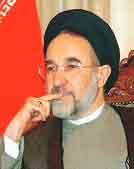Mohammad Khatami

(1943 - )
Mohammad Khatami is an Iranian scholar and politician who served as the fifth President of Iran from 1997 to 2005. He was succeeded by Mahmoud Ahmadinejad.
Khatami (born October 14, 1943) was born in the small town of Ardakan in central Iran. Khatami's father, Ruhollah, was a high-ranking cleric during the early years of the Iranian Revolution. Khatami received a B.A. in Western philosophy from Isfahan University, but left academia to complete his studies in Islamic sciences at Qom, where he stayed for seven years and completed the courses to the highest level, Ijtihad. After that, he went to Germany to chair the Islamic Centre in Hamburg from 1978 to 1980.
Before serving as president, Khatami had been a representative in the parliament from 1980 to 1982, supervisor of the Kayhan Institute, Minister of Culture and Islamic Guidance (1982–1986), and then for a second term from 1989 to May 24, 1992 (when he resigned), the head of the National Library of Iran from 1992 to 1997, and a member of the Supreme Council of Cultural Revolution.
Running on a reform agenda, Khatami was elected president on May 23, 1997 in what many have described as a remarkable election. Voter turnout was nearly 80%. Despite limited television airtime, most of which went to conservative Speaker of Parliament and favored candidate Ali Akbar Nateq-Nouri, Khatami received 70 percent of the vote. "Even in Qom, the center of theological training in Iran and a conservative stronghold, 70% of voters cast their ballots for Khatami." He was re-elected on June 8, 2001 for a second term and stepped down on August 3, 2005 after serving his maximum two consecutive terms according to the Islamic Republic's constitution.
Khatami supporters have been described as a "coalition of strange bedfellows, including traditional leftists, ... business leaders who wanted the state to open up the economy and allow more foreign investment" and "women and younger voters." The day of his election, the 2nd of Khordad, 1376, in the Iranian calendar, is regarded as the starting date of "reforms" in Iran. His followers are therefore usually known as the "2nd of Khordad Movement".
Khatami is regarded as Iran's first reformist president, since the focus of his campaign was on the rule of law, democracy and the inclusion of all Iranians in the political decision-making process. However, his policies of reform led to repeated clashes with the hardline and conservative Islamists in the Iranian government, who control powerful governmental organizations like the Guardian Council, whose members are appointed by the Supreme Leader. Khatami lost most of those clashes, and by the end of his presidency many of his followers had grown disillusioned with him.
As President, according to the Iranian political system, Khatami was outranked by the Supreme Leader. Thus, Khatami had no legal authority over key state institutions: the armed forces, the police, the army, the revolutionary guards, the state radio and television, the prisons, etc. Khatami presented the so called "twin bills" to the parliament during his term in office, these two pieces of proposed legislation would have introduced small but key changes to the national election laws of Iran and also presented a clear definition of the president's power to prevent constitutional violations by state institutions. Khatami himself described the "twin bills" as the key to the progress of reforms in Iran. The bills were approved by the parliament but were eventually vetoed by the Guardian Council.
Sources: Iran Intelligence; BICOM |